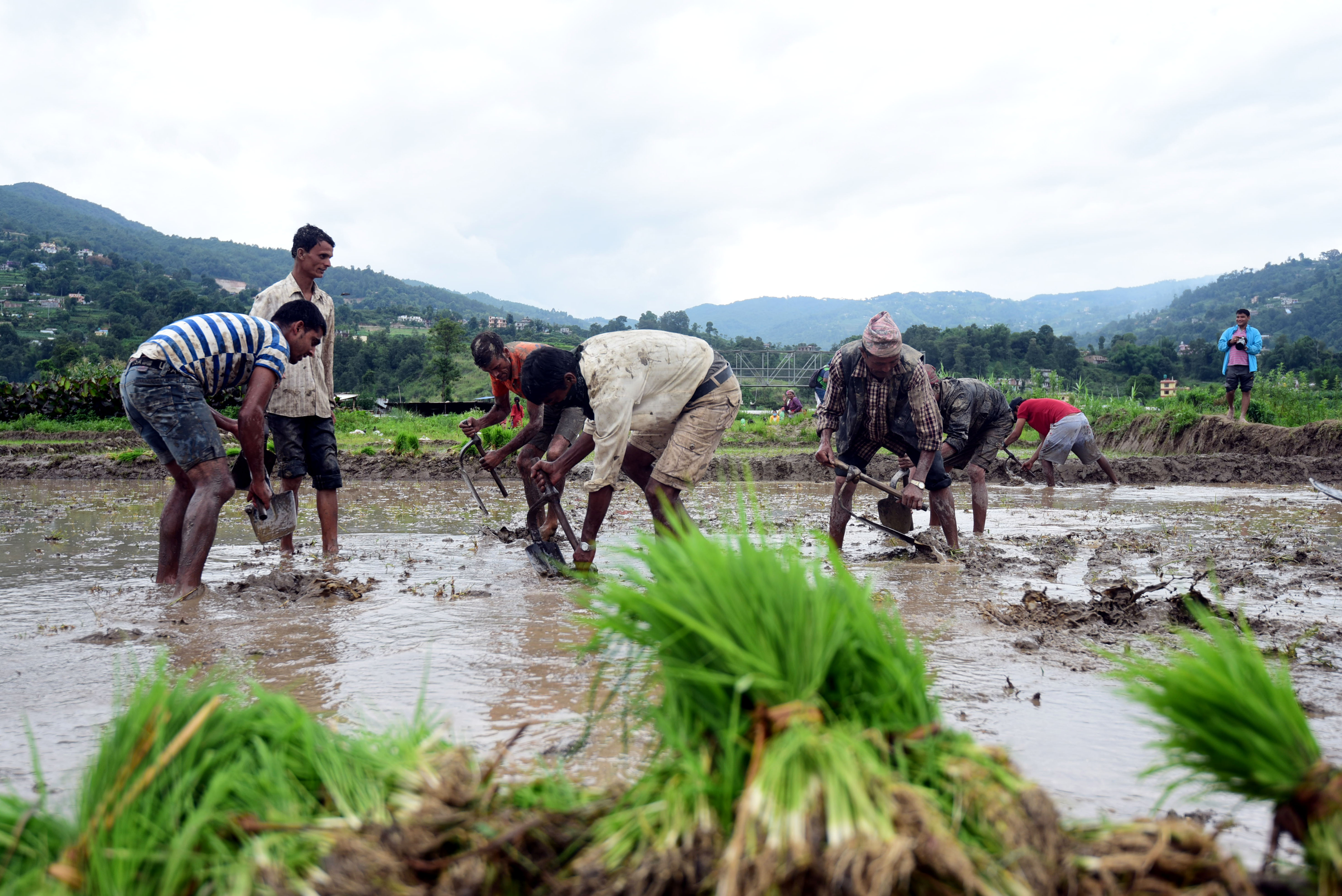
“Have you eaten rice?”, the first thing someone would ask if you meet them during late morning and evening hours. Rice is one and only major diet, which we have been enjoying on our table since our birth. Are we aware of how we are getting this stuff on our table? Rice is a staple food crop of Nepal, which is planted in 14 lakhs hectares all around Nepal, producing 55 lakh tons of food grains. On average, a Nepali consumes 120 Kg of rice per year, which supplies 40% of calorific requirements and 23% of protein requirements in the Nepalese diet. Likewise, it is viewed as one of the major commodity of national economy, which shares 20% of AGDP and 7% of national GDP. Due to its social and economic importance, it is rather viewed as a culture, merely than a crop commodity.
The monsoon has just entered in the country. With the onset of monsoon, farmers around the country set their schedule to puddle their fields for paddy (an unprocessed form of rice) plantation. The course generally starts with nursery raising, caring them for 20 to 25 days, and later transplanting them in the main field. Apart from just cultivating a crop, rice cultivation has something more significance for Nepalese farming community. A maxim, “Mana ropyera, muri falaunebela”, can be somewhat archaic but still, hold true and encouraging for the farming communities.
Generally, the monsoon starts in Nepal form June 10 and remains till September 23, lasting for 105 days. During this time around 80% of the annual rainfall takes place. This year monsoon in Nepal has started from June 12, right after the start of monsoon, farmers’ start dapper their fields to make themsuitable for paddy cultivation. In hilly areas, fields are seen filled with farmers with assigned roles during cultivation. Some are assigned as hali; one who handles the ox for plowing. rophar; one who plants rice seedlings, bause;one who labels the field, bihade; one who uproots the seedlings and doke; one who carries the uprooted seedlings. But with mechanization in rice plantation, these all duties are taken by rice planter, especially in Terai cropping pattern. The cultivation is often observed as a festival in some communities of mid hills and high hills. In western mid hills, maijharo is done after the cultivation of all fields to celebrate the end of cultivation. Moreover, the government has also declared Asad 15, as national rice day.
The cultivation is followed by meticulous care of planted seedlings. The first comes with the management of water, which is one of the limiting factor of rice production.Rice plant consumes 4000-5000 liters of water to produce 1 kilogram of grain. The second isthe management of weeds that competes with rice’s food - sunlight, water, nutrients; that rice needs for its growth and development. It is done twice at an interval of 30 days within 60 days of plantation. The third is the management of fertilizers, which are the major food source for rice plants. Different fertilizer supplies different nature of nutrients to the rice plant, for instance,Farm Yard Manure (FYM) supplies composite nutrients but in limited amount, Urea supplies Nitrogen; which is necessary for leaf development- a part that synthesizes food to the plant, Single Super Phosphate which supplies Phosphorous- which helps for grain filling and development.
The final management comprises insects and pests. They are the creatures, which trouble for healthy growth of rice plants. They feed on rice leaves, stem, grain and roots making grain production limited for human consumption. In some cases, rice plants are infected by deadliest diseases, killing them completely or reducing their yield. We have a historical example of Bengal famine in 1943, where the rice plants were infected by the disease called Brown Spot, which was caused by a fungus. The disease had reduced the yield of rice by 40-60% in West Bengal, killing 3 Million people with starvation and malnutrition. With this rigorous management for 120 days, the rice plant becomes full with grain-filled panicle- a part that holds the rice grains, and they are harvested.
The overall production cost of rice in an average is NPR 27,068 per hectare. Generally, a well-managed rice filed can produce 3 to 7 tons of grain per hectare depending on variety and management practices. The produce from commercial farms are purchased by processors at Minimum Support Price (MSP). It is a price which is declared by the government, before planting of crops for the purchases crops fromfarmers’ field. This year, the government has declared MSP of fine-textured rice NPR. 2,885 per quintals and of medium-textured rice NPR. 2,735 per quintals. At this price, farmers can sell their rice to the government, and Nepal Food Corporation reserves necessary stocks for feeding the people.
Though it seems quite straightforward, the course of getting rice on our table doesn’t end here. It pays labor of a Farmer, innovation of a Scientist, dedication of an Agronomist, and diagnosis of a Plant Pathologist. With the help of these actors, we people are being able to produce our food in a sustainable way, constantly increasing land productivity and ensuring food security in the country.
Author is currently a Graduate Student and young rice researcher focused on rice landraces at Department of Agronomy, Tribhuvan University.






Leave A Comment